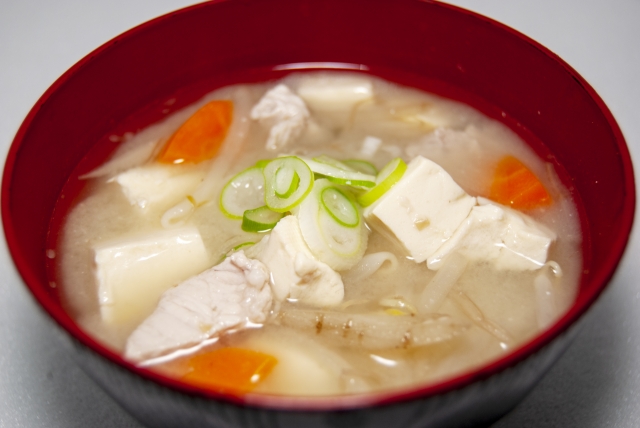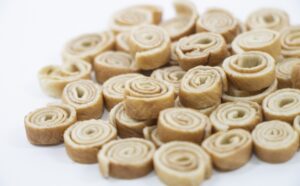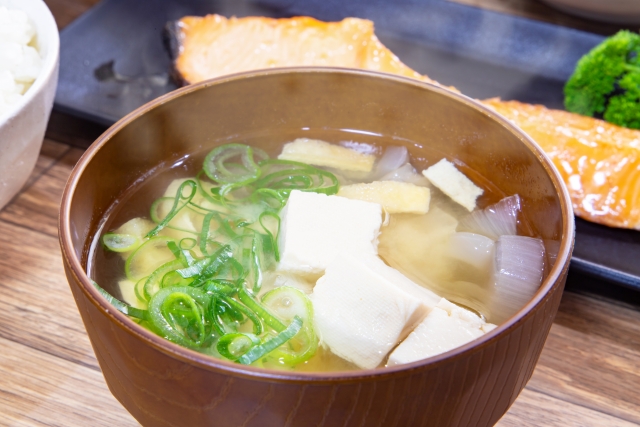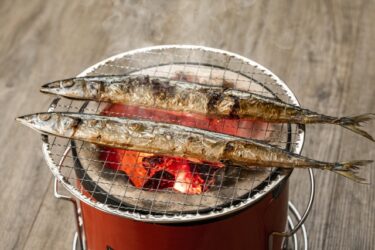In Japan, we often eat “sirumono”, which ingredients are in dashi-flavored soup.
When you order a Japanese menu at a restaurant, most of the time, “miso soup” is included as a set. Also, when buying a bento, many people buy miso soup in a cup together.
Miso soup is a soup seasoned with miso, but among them, “Tonjiru” containing pork is popular. Some restaurants in the city have a choice between miso soup and tonjiru.
In additio, there is a soup called “Osuimono” that contains almost no miso and tastes like soy sauce and dashi.
What is Miso soup and can I eat it?
| Gluten-free | Low-gluten | Wheat-free | ||
| with Pork |
| Restaurant | Food supermarket | Convenience store |
Miso soup ingredients and other Japanese-style soup
Materials of Miso soup
In the Japanese menu, you can often see a combination of rice, side dishes, and soup. When you order a set meal at a popular restaurant in the city, it’s almost always offered in a combination of the three.
There are many types of soup, but miso soup made with miso is the most common.

Miso is a seasoning peculiar to Japan that is fermented by adding jiuqu and salt to soybeans, rice, etc. There are also various types (see the commentary article on “Miso” for details).
Miso soup is a slightly salty soup seasoned with miso and dashi, with multiple ingredients added. The juice has a light brown color of miso and is cloudy. Various ingredients are used, and here are some typical ones.
Wakame seaweed Plant-based and gluten-free.
Green onion Plant-based and gluten-free.
Usu-a-ge (Fried tofu) Tofu is sliced and fried in oil. It is plant-based and gluten-free.
Shijimi or clams (bivalves) The shells of bivalves are included. It’s gluten-free.
Sweet potatoes and taros Plant-based and gluten-free.
Fish fillet It’s gluten-free.
Fu Wheat gluten is baked. It’s plant-based, but it’s not gluten-free.
Besides above, there are an infinite number of miso soup ingredients. Basically, you can put anything in it.
When ordering at a restaurant, you cannot specify the ingredients of miso soup or the type of miso. You have to check what is in it after it is provided.
However, the miso soup called “Akadashi”, which uses miso made from soybeans called “Hatcho-miso” made in the Nagoya region, and the “Tonjiru”, which is pork miso soup described below are often distinguished from other miso soups.
Tonjiru

Tonjiru is miso soup containing pork and several kinds of vegetables, and is characterized by having more ingredients and more volume than other miso soups.
Therefore, in addition to eating it as a soup with side dishes and rice, Tonjiru may be used as a side dish. For example, at a set meal restaurant in the city, there is also a menu called Tonjiru set meal, which consists of Tonjiru and rice.
The ingredients often used in Tonjiru are as follows;
- Pork (often uses fatty ribs)
- Burdock
- Radish
- Carrot
- Taro
- Leek
- Mushrooms
Normally, none of the ingredients used in Tonjiru contain gluten except soy sauce.
Osuimono

The soup is made from dashi seasoned with salt or soy sauce and contains ingredients, and the color of the soup is generally transparent. It is often served as a traditional Japanese dish such as kaiseki cuisine.
There are many types here as well, and some of them contain a small amount of miso, but salt, soy sauce, and dashi are the basic seasonings.
The following are used as ingredients.
- Fu
- Wakame seaweed
- Seafood
- Vegetavle
- Wild plants
- Mushroom
- Chicken meat


Try to eat Miso soup!
How much ?
There are few cases where only miso soup is sold at restaurants, but it is $ 1~1.5. Tonjiru is even more expensive, costing $ 1.5~3.
As I will explain later, instant miso soup and pork soup are sold for $ 1~2.
Precautions when eating Miso soup
For gluten-free people
Fu is baked gluten, so please do not eat it. Wheat is used as the raw material for soy sauce, but the protein is not decomposed and remains during the brewing process. If you have celiac disease, decide for yourself whether to eat. If you are gluten-free except for celiac disease, you can eat it.
For Muslims
Except of Tonjiru, it does not contain any problematic ingredients. However, the ingredients for miso soup have not been decided, so you should check it before eating.
Japanese writer’s comment for Miso soup
Miso soup and Tonjiru, which can be made simply by pouring hot water, are sold at food supermarkets and convenience stores. Some of the freeze-dried products have a quality similar to that of restaurant miso soup. There are two types, one is to put the contents in a container prepared by yourself and pour hot water, and the other is to put it in a cup and just pour hot water.
There is an instant Osuimono that can be made by pouring hot water into the powder. It is a product called “Matsutake no-agi Osuimono” from a company called Nagatanien, and Japanese people have eaten it once. Matsutake is mushroom that can be harvested in the fall and are valuable because they cannot be cultivated artificially. Although it has a unique scent, this product faithfully reproduces the scent of matsutake mushrooms. The price is as low as $ 1 for 4 meals.



